Cycle 25 sunspot region, Coronal hole faces Earth
Wednesday, 13 November 2019 18:02 UTC

A small sunspot region has rotated into view on the south-east limb. No big deal you say? Well... it might be a sign of things to come! More on that later. We also have a southern hemisphere coronal hole facing our planet today which could spark some high latitude aurora in a few days time. Plenty to talk about today!
Solar Cycle 25 sunspot region
A small sunspot region has rotated into view on the south-east limb. The NOAA SWPC has assigned sunspot number 2752 to this sunspot region earlier today. The region consists of multiple sunspots but all of them are very small. A substantial amount of facuale surrounds the sunspot region which could indicate the region might have been bigger on the far side and has decayed over the past few days. The most interesting thing about this sunspot region is that it is most certainly a sunspot region that belongs to the upcoming Solar Cycle (SC) 25. It is at a high latitude (sunspot regions from SC24 pop up near the equator) and of opposite polarity compared to sunspot regions from SC24 in the same hemisphere. Two key benchmarks indicating we are dealing with a sunspot region from SC25.
Make no mistake, we could see solar minimum like conditions for many more months to come but we have seen slightly more solar activity in the southern hemisphere the past few weeks which could mean Solar Cycle 25 is slowly starting to get a grip on the Sun's southern hemisphere. It is a sign that Solar Cycle 24 is slowly coming to an end and Solar Cycle 25 is starting to show its face. The Sun's northern hemisphere is much more quiet. It's not uncommon that one hemisphere shows more or less activity than the other but this activity in the southern hemisphere is something I thought would be interesting to point out.
Also, in case you are wondering... this sunspot region is of course not complex enough to produce C, M or X-class solar flares.
Coronal hole faces Earth
A northern extension of the southern polar coronal hole is facing our planet today. A high speed solar wind stream from this coronal could arrive this Saturday (16 November). Based on its performance during the previous rotation, we expect at most a Kp of 3 which would only be enough for high latitude locations but if you are one of the lucky ones at such a location and have access to clear skies... by all means be alert for aurora as we head into the weekend!
A southern hemisphere coronal hole is facing Earth. Enhanced solar wind could arrive in ~3 days - Follow live on https://t.co/bsXLid5YhH pic.twitter.com/7PxvEZe2YK
— SpaceWeatherLive (@_SpaceWeather_) November 13, 2019
Thank you for reading this article! Did you have any trouble with the technical terms used in this article? Our help section is the place to be where you can find in-depth articles, a FAQ and a list with common abbreviations. Still puzzled? Just post on our forum where we will help you the best we can!
Latest news
Latest forum messages
Support SpaceWeatherLive.com!
A lot of people come to SpaceWeatherLive to follow the Sun's activity or if there is aurora to be seen, but with more traffic comes higher server costs. Consider a donation if you enjoy SpaceWeatherLive so we can keep the website online!

Space weather facts
| Last X-flare | 2025/03/28 | X1.1 |
| Last M-flare | 2025/04/01 | M2.5 |
| Last geomagnetic storm | 2025/03/27 | Kp5 (G1) |
| Spotless days | |
|---|---|
| Last spotless day | 2022/06/08 |
| Monthly mean Sunspot Number | |
|---|---|
| February 2025 | 154.6 +17.6 |
| April 2025 | 152.5 -2.1 |
| Last 30 days | 130.7 -17.9 |


